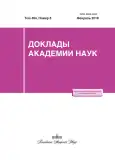Origin of hydrocarbons in suspended matter and bottom sediments near the Crimean peninsula
- Authors: Nemirovskaya I.A.1, Oneginа V.D.1, Lisitzin A.P.1, Konovalov B.V.1
-
Affiliations:
- Shirshov Institute of Oceanology, Russian Academy of Sciences
- Issue: Vol 484, No 5 (2019)
- Pages: 600-604
- Section: Geochemistry
- URL: https://journals.eco-vector.com/0869-5652/article/view/12780
- DOI: https://doi.org/10.31857/S0869-56524845600-604
- ID: 12780
Cite item
Abstract
It was established that the content of hydrocarbons in the surface waters of the Feodosia Gulf fluctuated were varied a wide range (11–179 μg/l), and exceeded the MPC values for petroleum hydrocarbons in individual samples. The highest concentrations were observed in 2016. The composition of alkanes suggested their mixed (autochthonous and allochthonous) origin. The weathered petroleum hydrocarbons have been identified only in a few cases. In bottom sediments, the concentrations of hydrocarbons depended on their grain size distribution, and terrigenous alkanes were dominated in their composition. The oil and pyrogenic hydrocarbons’ pollution were established based on the composition of polycyclic aromatic hydrocarbons. In the open part of the Black Sea, southward the Crimean peninsula, the hydrocarbon content in surface waters and bottom sediments were at the level of background concentrations, and homologs of terrigenous origin dominated in their composition.
About the authors
I. A. Nemirovskaya
Shirshov Institute of Oceanology, Russian Academy of Sciences
Author for correspondence.
Email: nemir44@mail.ru
Russian Federation, Moscow
V. D. Oneginа
Shirshov Institute of Oceanology, Russian Academy of Sciences
Email: nemir44@mail.ru
Russian Federation, Moscow
A. P. Lisitzin
Shirshov Institute of Oceanology, Russian Academy of Sciences
Email: nemir44@mail.ru
Academician of the RAS
Russian Federation, MoscowB. V. Konovalov
Shirshov Institute of Oceanology, Russian Academy of Sciences
Email: nemir44@mail.ru
Russian Federation, Moscow
References
- Лаврова О.Ю., Митягина М.И., Костяной А.Г. Спутниковые методы выявления и мониторинга зон экологического риска морских акваторий. М.: ИКИ РАН, 2016. 334 с.
- Ижицкий А.С., Завьялов П.О. // Океанология. 2017. Т. 57. № 4. С. 538–545.
- Качество морских вод по гидрохимическим показателям. Ежегодник 2015 / Под ред. А.Н. Коршенко. М.: Наука, 2016. 184 с.
- Ломакин П.Д., Чепыженко А.И., Чепыженко А.А. // Экол. безопасность прибрежной и шельфовой зон и комплекс. исслед. ресурсов шельфа. 2006. № 14. С. 245–258.
- Немировская И.А. Нефть в океане (загрязнение и природные потоки). М.: Науч. мир, 2013. 432 с.
- Немировская И.А., Онегина В.Д., Коновалов Б.В. // Мор. гидрофиз. журн. 2017. № 4. С. 48–60.
- Перечень рыбохозяйственных нормативов предельно допустимых концентраций и ориентировочно безопасных уровней воздействия вредных веществ для воды водных объектов, имеющих рыбохозяйственное значение. Госкомитет РФ по рыболовству. М.: ВНИРО, 1999. 304 с.
- Израэль Ю.А., Цыбань А.В. Антропогенная экология океана. М.: Наука, 2009. 532 с.
- Эглинтон Дж., Мерфи М.Т. Дж. Органическая геохимия. Л.: Недра, 1974. 487 с.
- Peters K.E., Walters C.C., Moldowan J.M. The Biomarker Guide: Biomarkers and Isotopes in Petroleum Systems and Earth History. Cambridge: Cambridge Univ. Press, 2005. 1155 p.
- Tolosa I., Mora S., Sheikholeslami M.R., et al. // Mar. Pol. Bul. 2004. V. 48. P. 44–60.
- Кушнир В.М., Поважный В.В., Бердников С.В. // Мор. гидрофиз. журн. 2014. № 2. С. 22–31.
- Матишов Г.Г., Степаньян О.В., Харьковский В.М., Сойер В. Г. // Вестн. Южн. науч. центра. 2014. Т. 10. № 4. С. 49–52.
- Wakeham S.G. // Mar. Chem. 1996. V. 53. P. 187–205.
- Readman J.W., Fillmann G., Tolosa I., Bartocci J., Villeneuve J-P., Catinni C., Mee L.D. // Mar. Pol. Bul. 2002. V. 44. Р. 48–62
Supplementary files








